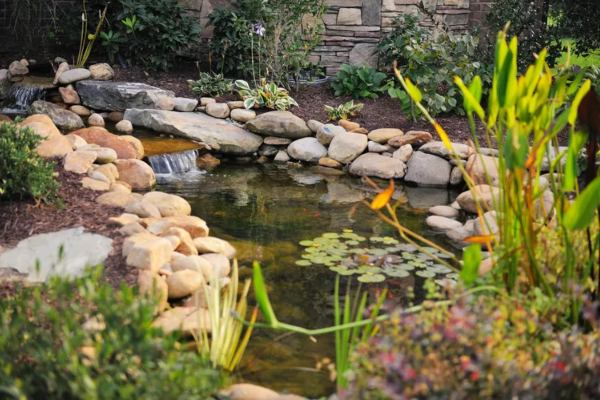Growing plants in the soil is quite a task, but how about raising them in the water? If you’d love admiring someone else’s aquatic landscape features, get your feet wet trying to create one in your garden.
Water gardens are a great way of seamlessly blending aquatic plants and animals with a habitable environment. If you want to build a water garden, it will give you a focal point for your yard makes it look serene and beautiful.
The garden with rippling waterfalls, floating water lilies, and an extraordinary landscape feature might look impossible to install and maintain in your yard. But that’s not the case. Even a beginner gardener can take care of a water garden and relish its soothing sounds after a bad day.
What are water gardens?
Water gardens also commonly known as aquatic gardens are a water feature that shows a collection of various water plants. Some people may see this as fish ponds or garden ponds, but it’s mainly the aquatic plants that make it a water garden.
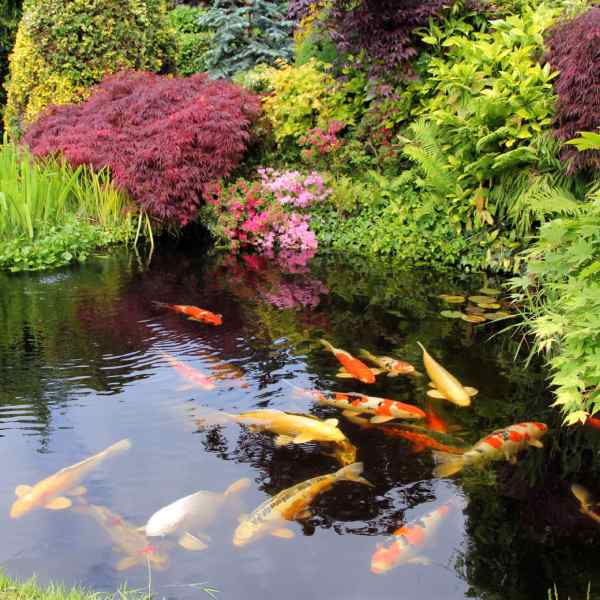
In simple words, a water garden is an aquatic ecosystem that has an artificial water feature like a pond with aquatic plants and animals like fish or frogs.
Benefits of water gardens
A water garden is functional and eye-catching at the same time:
- Conserve water: Water collected from rain can be turned into a water garden.
- Improve appearance: A water garden makes your yard look beautiful and interesting.
- Build a natural habitat: Aquatic plants and animals support each other in this ecosystem.
- Increase property value: A properly designed built-in water garden increases the resale value of a home.
Main features
Water gardens normally have four main elements: a water feature, clean water, plants, and animals.
- Water feature: The water feature can be a waterfall, pond, bog, or stream.
- Water: In the water garden, you can use ordinary water from a hose or clean rainwater collected in rain barrels.
- Plants: You might have guessed from the name itself, that a water garden requires a range of floating, bog, submerged, and deep-water plants.
- Animals: Fish, snails, and frogs are some of the animals that live in water gardens.
Types of Water Gardens
Water gardens look like real ponds, but a container water garden is less costly and more easy to build.
Built-In water garden
A built-in water garden looks like a natural pond. You can line an artificial garden pond with plastic, concrete, or granular bentonite clay.
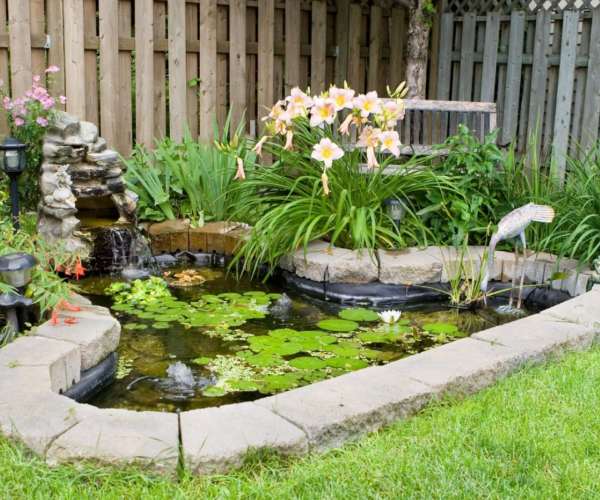
A built-in water garden looks more like a natural water feature and can easily blend with the rest of the yard. The depth of the water garden can vary as you need. In some cases, this garden takes the longest time to build. Also, if there are some buried obstructions, a built-in garden may not be buildable and it is one of the most expensive gardens to build.
Container water garden
A container water garden features a collection of containers of different sizes like barrels and tubs, kept closely together.
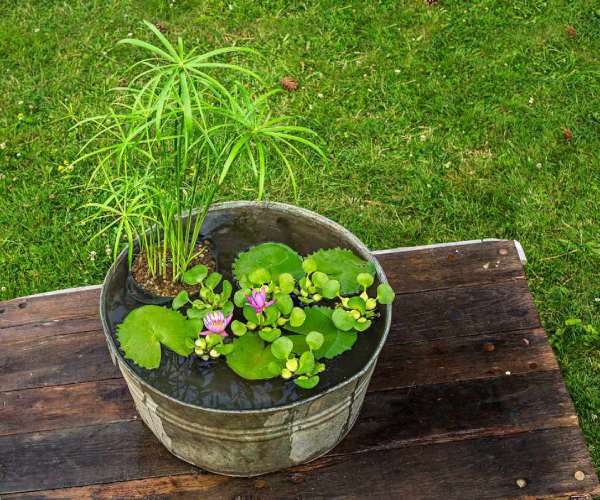
This is the most flexible type as one can easily arrange and rearrange it. The good part is it can be installed on patios or weight-bearing decks.
Above-ground water garden
This water garden is built from the ground upward with little or no digging needed. This allows the garden to avoid possible complications with buried pipes and wires.
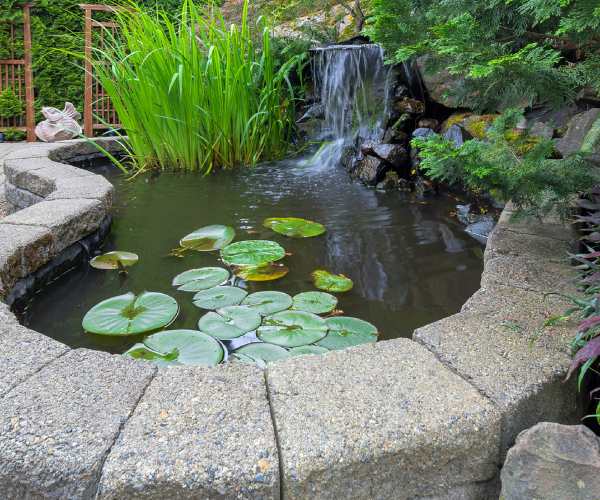
For making an above-ground water garden, you can use stock tanks or it could be custom-built with masonry and liner materials.
What plants can be kept in a water garden?
Plants are the reasons why a water garden is a garden and not just a pond. You can keep many types of aquatic plants, including all four types of plants—floating, bog, submerged, and deep water—or as many as you need, depending on the type of water garden.
Floating plants
As you might have guessed from the name, floating plants plant on the water’s surface. The water itself is the nutrient base for the plants. Since floating plants are a natural shade, they help to control algae bloom. They further limit algae growth by drawing nitrogen from the water. Duckweed, Azolla, duckweed, fairy moss, water hyacinth, and water lettuce are some examples of floating plants.
Bog or shallow marginal plants
If you don’t know, a bog in a water garden means an area of water that is 1 and 4 inches deep. Bogs are present in all water gardens, either in-ground, above-ground, or container. They add color and texture to water gardens, making them look vibrant and fun. Some examples are cattails, water pickerel, parrot’s feather, and water poppy.
Submerged or oxygenator plants
Unlike floating plants, submerged plants float in the water just below the surface. These plants or oxygenators soak for excess nutrients from the water, allowing them to limit algae growth. Some oxygenator plants include anacharis, cabomba, hornwort, and vallisneria.
Deep water plants
Deep-water plants in a water garden require at least 4 to 10 inches of water above them to thrive and survive. But that doesn’t mean the plants are hidden in the water. Some plants like lotus and water lilies are popular examples of deep-water plants that have very showy leaves or spikes on the surface.
These plants are responsible for keeping ponds cool and they also provide shade to fish and other water animals. Golden Club is another well-known example.
Also, Read Propagate Fiddle-Leaf Figs in Water or Soil
Water garden animals
Many aquatic animals and amphibians are part of the water garden. A fish named Koi is a common water animal in water gardens.
These fish must be fed regularly but not more than decomposing on the water surface.
While fish add life to a water garden and are eye-catching objects, they can damage the plants as well because they eat leaves and uproot deep-water plants while moving or laying eggs, which is not good.
Where to create the water garden
It is best to locate the water garden near enough to the home, mostly in your garden so that you can enjoy its beauty and can easily maintain it. However, do not locate it so close that the water overflows and floods the foundation or basement.
A good six to eight hours of daily sunlight is necessary for most water gardens. The scorching sun can cause algae blooms.
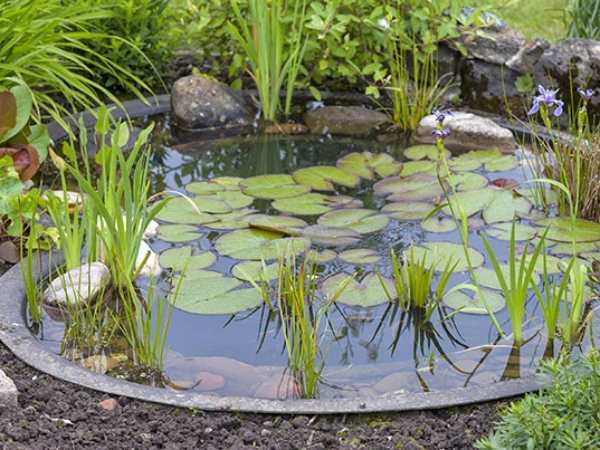
We recommend avoiding placing built-in water gardens above or near in-ground power lines or water mains. Consult a utilities locating service for the perfect location.
Container and above-ground water gardens are the safest for placing on the ground. But if you keep them on a balcony or a deck, consult a structural engineer or a contractor
Build a Water Garden
To build an in-ground water garden, it starts by building a pond and then keeping plants and animals in it.
- Create the shape: Create the water garden’s normal shape using a hose or rope.
- Check for utilities: Contact the utility locating service to check if there are any buried lines.
- Dig the pond: As per your desired depth, dig the pond, usually 18 to 36 inches by hand or using a digger.
- Smooth the pond: Sculpt the inside part of the pond using a flat-bladed shovel. In the case of deep ponds, terrace the slope downward rather than building sharp inclines.
- Add the liner: Unroll and keep the liner or cover the pond with granular bentonite clay.
- Cover the edges: Keep some flat stones like flagstones on the edge of the liner to cover it.
- Install the filter and pump: Install the water filter and pump and plug them into a CFGI outlet.
- Add water: Turn the garden hose on and fill the pond with water.
- Add water plants: Once the water reaches an adequate temperature, add aquatic plants of your preference like lilies, duckweed, water lilies, or water poppies.
- Add animals: You can finally add water animals like koi, pond snails, or turtles.
Maintenance
Since water gardens need to have weeds, algae and other unnecessary growth to be kept in check, they are normally high maintenance. You need to keep an eye on the water quality and maybe change it, if necessary.
- Control algae by reducing unnecessary extra nutrients in the pond.
- If the algae growth gets severe, change the water.
- Weed in and around your water garden.
- Look out for predators.
- Before fall arrives, cover the water garden with netting to keep leaves at bay.
- Shut down the pump and filter before winter.
- In early spring, clean the water garden.
FAQs
Q: How to create a simple water garden?
A: A container garden is a great way of creating the simplest form of water garden, and then adding necessary water plants and animals to it. You can also build a shallow in-ground water garden lined with bentonite clay.
Q: How deep does a water garden have to be?
A: An in-ground water garden is usually 18 to 36 inches deep. A good depth for a water garden is about 24 inches.
Also, Read How to Grow and Care for Climbing Roses and Choose the One for Your Garden!
